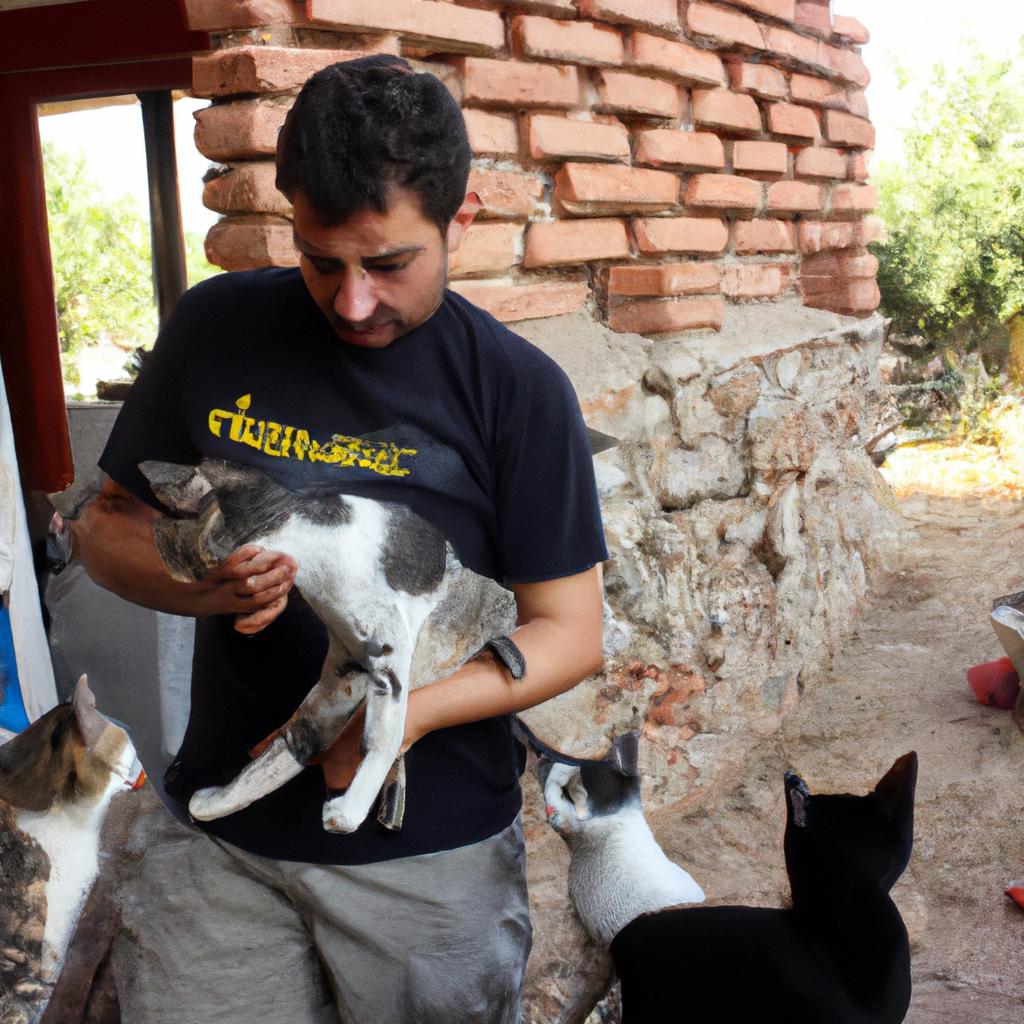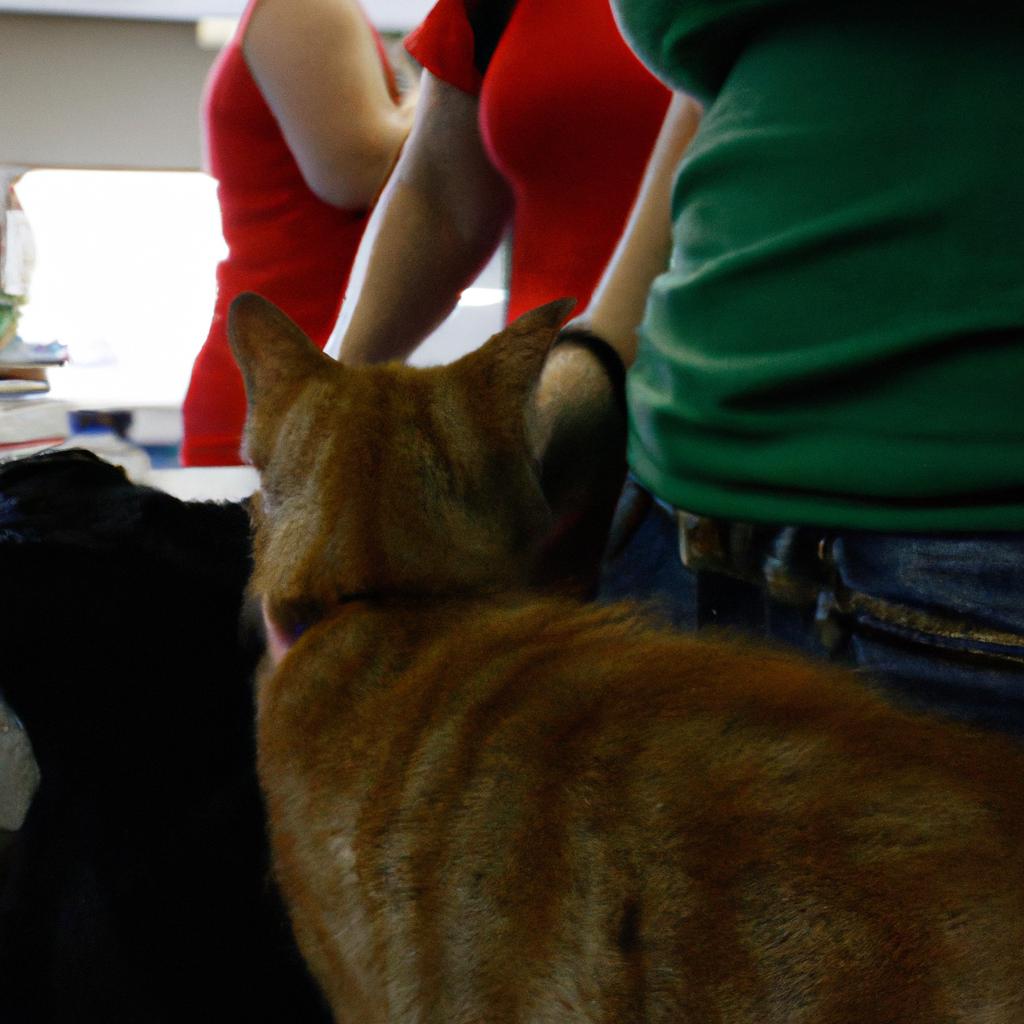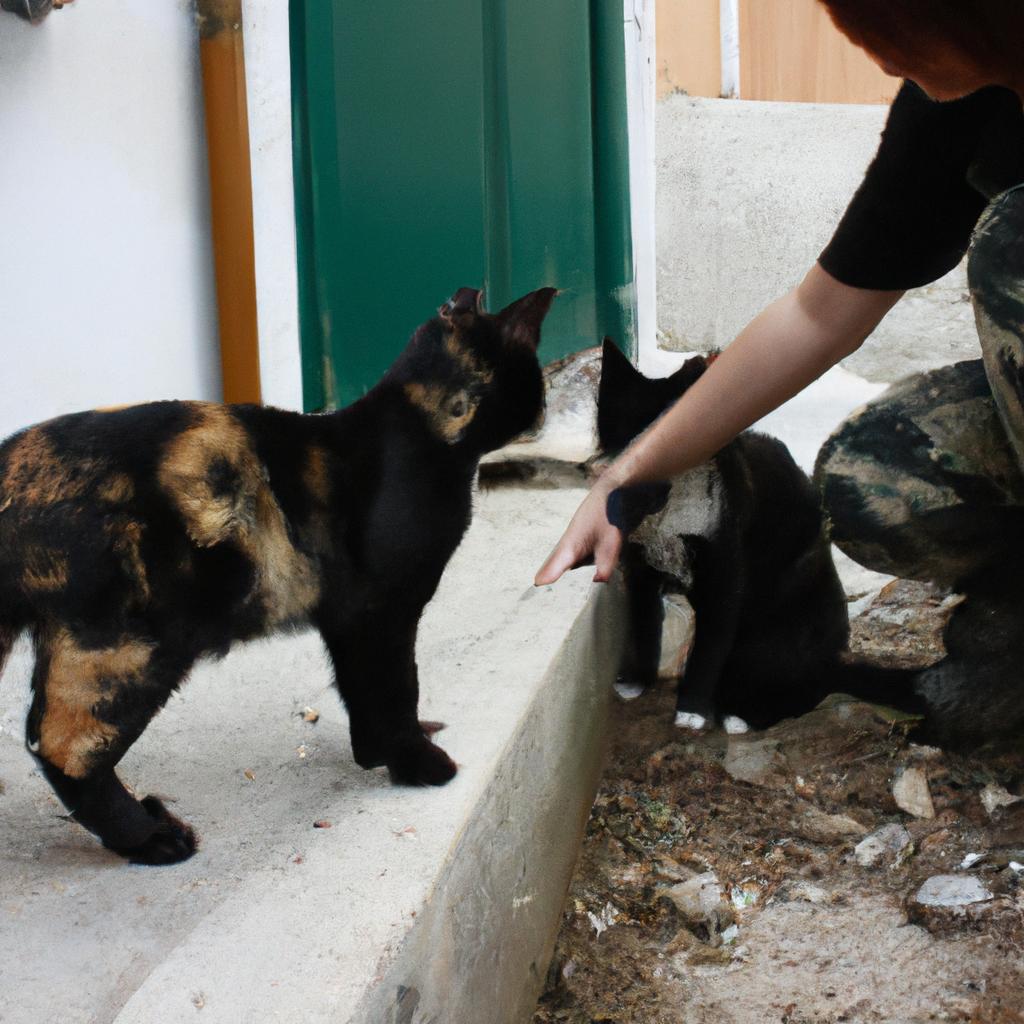Community outreach programs play a vital role in addressing the needs of various populations within society. One particular area that requires attention and support is cat rescue volunteer opportunities. By engaging in such activities, individuals can make a tangible difference in the lives of abandoned or neglected felines, while also contributing to the overall welfare of their communities. For instance, imagine a scenario where an elderly woman living alone in a neighborhood suddenly finds herself unable to care for her beloved cats due to health issues. Without any assistance, these animals would likely endure great suffering and face potential homelessness. However, through community outreach initiatives specifically focused on cat rescue, volunteers can step in and provide much-needed help by rescuing and rehoming these vulnerable creatures.
To further understand the significance of community involvement in cat rescue efforts, it is essential to recognize the existing challenges faced by stray or abandoned cats today. In many urban areas, overpopulation remains a pressing issue due to factors such as uncontrolled breeding and pet abandonment. As a result, countless felines find themselves roaming the streets without access to proper nutrition, shelter, or medical care. Moreover, this situation not only poses risks to the well-being of these animals but also contributes to concerns regarding public health and safety. Therefore, by actively participating in cat rescue volunteer opportunities, individuals can directly address these challenges and contribute to the betterment of their communities.
One significant benefit of community involvement in cat rescue efforts is the opportunity to provide a safe and secure environment for abandoned or neglected cats. By rescuing these animals and placing them in loving homes, volunteers help alleviate their suffering and improve their overall quality of life. Additionally, through spaying/neutering programs and vaccination initiatives, community outreach programs can effectively control the population of stray cats, reducing the risks associated with overpopulation.
Furthermore, cat rescue volunteer opportunities also allow individuals to make a positive impact on public health and safety. Stray cats often face various health issues that can potentially spread diseases or parasites to humans or other animals in the community. Through regular veterinary care and proper medical interventions provided by dedicated volunteers, these risks can be minimized, ensuring a healthier living environment for both humans and felines.
Moreover, engaging in cat rescue activities fosters a sense of compassion, empathy, and responsibility within individuals. It provides an avenue for people to actively contribute their time and effort towards a cause they believe in while developing valuable skills such as animal handling or fostering. This not only benefits the cats being rescued but also empowers volunteers to become advocates for animal welfare within their communities.
In conclusion, community involvement in cat rescue volunteer opportunities plays a crucial role in addressing the needs of abandoned or neglected felines while contributing to the overall well-being of society. By providing much-needed assistance to vulnerable animals, controlling overpopulation issues, promoting public health and safety measures, and cultivating compassion among individuals, these initiatives create lasting positive change within communities.
Why Community Outreach is Important for Cat Rescues
Community outreach plays a crucial role in supporting and expanding the efforts of cat rescues. By raising awareness, promoting adoption, and encouraging responsible pet ownership, these organizations can make a significant impact on the lives of countless feline companions. To illustrate this point, let’s consider the case study of a small cat rescue located in a rural community.
In this hypothetical scenario, the cat rescue faced several challenges due to limited resources and public knowledge about their existence. Without an effective outreach strategy in place, they struggled to find permanent homes for the cats in their care. However, once they implemented targeted community engagement initiatives, such as hosting educational workshops and participating in local events, they witnessed a remarkable transformation. The number of adoptions increased significantly, allowing them to save more cats from uncertain futures.
To evoke an emotional response among potential volunteers or supporters, we must recognize the tangible benefits that community outreach provides for both rescued cats and society at large. Consider the following bullet points:
- Increased adoption rates: Through engaging with the community directly and showcasing available cats through various channels (such as social media platforms or adoption drives), more individuals will be encouraged to adopt rather than purchase pets from breeders.
- Reduced euthanasia rates: By promoting spaying/neutering programs and educating people about responsible pet ownership practices like microchipping and vaccination, cat rescues can help decrease overpopulation problems and subsequently reduce euthanasia rates.
- Enhanced volunteer recruitment: Effective outreach campaigns not only attract potential adopters but also inspire new volunteers who are passionate about animal welfare causes.
- Strengthened partnerships: Collaborations with other animal welfare organizations or local businesses foster mutually beneficial relationships that provide additional support and resources for ongoing rescue efforts.
To further emphasize these key points while maintaining visual interest, below is a table highlighting specific examples of how community outreach positively impacts cat rescues:
| Benefits of Community Outreach | Examples |
|---|---|
| Increased awareness | Participating in local fairs and festivals to promote the rescue’s mission |
| Education | Conducting workshops on responsible cat care practices |
| Fundraising opportunities | Hosting charity events or partnering with businesses for donation drives |
| Collaborations | Partnering with veterinary clinics to offer discounted services |
In summary, community outreach is a vital component of any successful cat rescue organization. By actively engaging with the public, these initiatives not only help find forever homes for rescued cats but also contribute to broader efforts in reducing overpopulation and promoting responsible pet ownership. In the following section, we will explore steps individuals can take to get started as a cat rescue volunteer, further expanding the impact of community outreach efforts.
Steps to Get Started as a Cat Rescue Volunteer
Understanding the importance of community outreach for cat rescues, let’s now explore the steps to get started as a cat rescue volunteer. To provide you with a better understanding, consider the case study below:
Case Study:
Imagine Sarah, an animal lover passionate about helping cats in need. She decides to become a volunteer at her local cat rescue organization and begins her journey by following these steps:
Step 1: Research and Outreach
Sarah starts by researching different cat rescue organizations in her area. She reaches out to them via email or phone calls, expressing her interest in volunteering and asking for more information on opportunities available.
Step 2: Orientation and Training
Once Sarah finds a suitable organization, she attends an orientation session where she learns about their mission, goals, and policies. This helps her understand the overall operations of the organization and ensures that she aligns with their values. Following the orientation, Sarah undergoes specific training sessions tailored to tasks such as feeding, cleaning, socializing with cats, administering medication if necessary, or assisting with adoptions.
Step 3: Regular Commitment
To make a meaningful impact, Sarah commits to a regular schedule according to her availability. By consistently showing up at the shelter or rescue center during designated hours each week or month, she is able to build trust with both staff members and feline residents.
- Witnessing firsthand the transformation of scared or neglected cats into happy companions brings immense joy.
- The gratitude received from the rescued cats who find forever homes creates a sense of fulfillment.
- Being part of a compassionate community dedicated to saving lives instills a sense of purpose.
- Helping educate others about responsible pet ownership contributes towards creating a more humane society.
Emotional Table:
| Volunteer Activities | Impact | Benefits |
|---|---|---|
| Assisting with Adoptions | Finding loving homes | Bringing hope |
| Socializing with Cats | Improving their well-being | Providing comfort |
| Assisting in Fundraising | Financial support | Ensuring sustainability |
| Educating the Community | Promoting responsible ownership | Creating awareness |
Understanding the steps involved, we can now delve into the role of volunteers in cat rescue organizations.
The Role of Volunteers in Cat Rescue Organizations
Imagine a small community struggling to address its growing stray cat population. Without any organized efforts, these cats face numerous challenges and risks, such as malnutrition, disease, and the inability to find safe shelter. However, thanks to dedicated cat rescue volunteers, communities can tackle this issue effectively and provide these vulnerable felines with the care they need.
Volunteering in cat rescue organizations offers various opportunities for individuals passionate about animal welfare. Here are some key reasons why their involvement is crucial:
-
Providing essential care: Cat rescue volunteers play a vital role in providing basic necessities for rescued cats. They ensure that each feline receives proper nutrition, medical attention, and a safe environment until suitable permanent homes can be found.
-
Assisting with adoption processes: Volunteers help streamline the adoption process by conducting interviews with potential adopters, organizing meet-and-greets between cats and prospective owners, and ensuring all necessary paperwork is completed accurately.
-
Educating the community: Volunteers have an opportunity to educate the local community on responsible pet ownership and the benefits of adopting from shelters rather than purchasing pets from breeders or pet stores. By raising awareness about spaying/neutering programs and other preventative measures, they contribute significantly to reducing future instances of stray cat populations.
-
Fostering emotional connections: Through their dedication and compassion towards abandoned animals, volunteers create lasting bonds that benefit both humans and felines alike. These connections not only improve the well-being of individual cats but also foster a sense of empathy within the community towards animal welfare issues.
The following table highlights some ways in which cat rescue volunteers make a positive impact:
| Ways Cat Rescue Volunteers Make a Difference |
|---|
| Provide shelter |
| Assist with veterinary care |
| Conduct behavioral assessments |
| Facilitate adoptions |
By actively participating in volunteer work at cat rescue organizations, individuals become catalysts for change within their communities. Their efforts not only save the lives of countless cats but also contribute to creating a more compassionate society that values and protects all animals.
Understanding the importance of cat rescue volunteers, it becomes evident how their dedication and hard work result in numerous positive outcomes for both felines and humans alike.
How Cat Rescue Volunteers Make a Difference in the Community
Transitioning seamlessly from the previous section, let’s explore how cat rescue volunteers make a tangible impact on their communities. To illustrate this point, let’s consider the case of Sarah, a passionate volunteer who dedicates her time and energy to rescuing cats in need.
Sarah began volunteering at her local cat rescue organization three years ago. Through her consistent efforts, she has witnessed firsthand how cat rescue volunteers contribute positively to their communities. By providing essential services such as fostering, feeding, and socializing cats awaiting adoption, volunteers like Sarah play a crucial role in ensuring that these animals receive proper care and attention.
Here are some ways in which cat rescue volunteers make a difference:
- Fostering Cats: Volunteers often open up their homes to provide temporary shelter for rescued cats. This not only helps alleviate overcrowding at shelters but also gives individualized attention to each feline companion.
- Socialization and Rehabilitation: Many cats come from challenging backgrounds or have experienced trauma. Dedicated volunteers work patiently with these animals to help them regain trust in humans and prepare them for successful adoptions.
- Adoption Events: Volunteers organize adoption events where potential adopters can meet rescued cats. These events create opportunities for forever homes while raising awareness about responsible pet ownership within the community.
- Educational Initiatives: Volunteers engage in educational programs aimed at promoting responsible pet ownership among community members. They offer advice on topics such as spaying/neutering, vaccination schedules, and general cat care.
To further emphasize the significance of these contributions, we can take a look at the following table showcasing statistics regarding the impact of dedicated cat rescue volunteers:
| Category | Statistics |
|---|---|
| Rescued Cats | 500+ |
| Successful Adoptions | 300+ |
| Volunteer Hours | 10,000+ |
| Community Outreach Events | 20+ |
These numbers represent real-life examples of the remarkable efforts made by cat rescue volunteers. By dedicating their time and expertise to support these organizations, they significantly contribute to improving the lives of cats in need.
In light of these findings, it is evident that cat rescue volunteers play a vital role in creating healthier communities for both the feline companions they help and the humans who benefit from their presence. In our next section, we will explore some valuable tips for individuals interested in embarking on a successful cat rescue volunteer experience, ensuring that their contribution has an even greater impact.
Transitioning smoothly into our subsequent section about “Tips for a Successful Cat Rescue Volunteer Experience,” let’s dive deeper into how you can make your journey as a volunteer more rewarding and effective.
Tips for a Successful Cat Rescue Volunteer Experience
By actively participating in cat rescue efforts, volunteers contribute to the overall well-being of their community. However, the impact of volunteering goes beyond just helping cats find loving homes. Let’s explore some of the benefits that individuals can experience when they become involved with cat rescue organizations.
Paragraph 1:
To illustrate one example, consider Sarah, a dedicated volunteer at her local cat shelter. Through her efforts, she has not only saved numerous feline lives but also experienced personal growth and fulfillment. Sarah found purpose in providing comfort and care to abandoned and neglected cats, witnessing firsthand their transformation into happy and healthy companions. This case study exemplifies how volunteering for cat rescue organizations can be immensely rewarding on both an emotional level and as a means of acquiring valuable skills.
Paragraph 2 (Bullet Point List):
Volunteering for cat rescue organizations offers various advantages:
- Fulfillment: Contributing to saving innocent lives brings a sense of accomplishment and fulfillment.
- Community Engagement: By joining forces with like-minded individuals, volunteers establish connections within their community.
- Skill Development: Volunteers gain practical experience handling animals, administering medications, and learning about veterinary practices.
- Emotional Well-being: Providing love and care to vulnerable animals can have positive effects on mental health.
Paragraph 3 (Table):
Here is a table highlighting some key benefits of volunteering for cat rescue organizations:
| Benefit | Description |
|---|---|
| Increased Empathy | Caring for rescued cats fosters empathy towards other living beings |
| Social Interaction | Opportunities to interact with fellow volunteers who share similar passions |
| Personal Growth | A chance to discover new strengths and develop personal qualities |
| Sense of Purpose | Knowing that your contribution makes a difference provides a strong sense of purpose |
With these significant benefits in mind, it becomes clear that volunteering for cat rescue organizations is not only a selfless act but also an opportunity for personal growth and development.
Understanding the positive impact of community outreach on cat adoption rates can further inspire individuals to get involved in these volunteer opportunities.
Impact of Community Outreach on Cat Adoption Rates
In recent years, community outreach programs focusing on cat rescue have played a crucial role in increasing adoption rates and providing volunteer opportunities for individuals passionate about animal welfare. These initiatives aim to raise awareness about the importance of adopting cats from shelters, promote responsible pet ownership, and actively engage with local communities. By highlighting success stories and showcasing the positive impact of these programs, more people are inspired to get involved.
One compelling example is the case of Smithville Animal Shelter’s partnership with a local school. Through their joint efforts, they organized an educational workshop where students were taught about the benefits of adopting shelter cats. This engagement not only educated young minds but also encouraged them to spread the message within their families and neighborhoods. As a result, several families visited the shelter and adopted cats that had been waiting for loving homes.
- Increased public awareness about homeless cats
- Encouragement for potential adopters to visit shelters
- Promotion of spaying/neutering campaigns
- Formation of lasting connections between volunteers and rescued animals
Additionally, let us explore a table that highlights how various aspects of community outreach positively affect cat adoption rates:
| Aspect | Effect |
|---|---|
| Public Awareness | Higher visibility for sheltered cats |
| Education | Understanding benefits of adoption |
| Volunteer Engagement | Enhanced care provided at shelters |
| Collaborative Efforts | Wider reach through partnerships |
Through effective community outreach strategies such as workshops, social media campaigns, and collaborations with other organizations or schools, cat rescue groups can make a significant difference in finding forever homes for countless feline companions.
These collective efforts help create a compassionate society where everyone understands the value of caring for vulnerable animals. By continuing to support these initiatives, we can ensure a brighter future for cats in need and promote responsible pet ownership within our communities.




